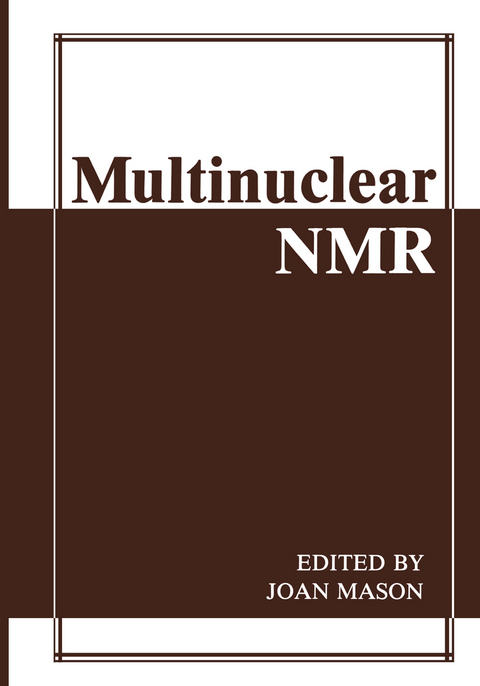
Multinuclear NMR
Springer-Verlag New York Inc.
978-1-4612-8999-9 (ISBN)
1 Introduction.- 2 The Parameters of NMR Spectroscopy.- 1. Nuclear Properties of the Elements and the Resonance Condition.- 2. The Nucleus in a Chemical Environment.- 3. The Larmor Precession and the Bloch Equations.- 4. The Fourier Transform Technique.- 5. Multipulse and Multiple Resonance Techniques.- 6. Oriented Systems.- 7. The NMR Time Scale.- 8. Physical Effects on the NMR Parameters.- References.- 3 The Chemical Shift.- 1. Nuclear Magnetic Shielding and the Chemical Shift.- 2. Theoretical Description.- 3. Patterns of Chemical Shifts.- 4. Correlations of Chemical Shifts with Other Molecular Properties.- 5. Shifts in Paramagnetic Systems.- 6. Effects of Intermolecular Interactions and Intramolecular Dynamics.- References.- 4 Spin-Spin Coupling.- 1. General Considerations.- 2. Empirical Patterns of Coupling Constants.- 3. Effects of Intermolecular Interactions and Intramolecular Dynamics on Spin-Spin Coupling.- 4. Theoretical Description.- References.- 5 Relaxation and Related Time-Dependent Processes.- 1. Importance.- 2. Definitions.- 3. Microscopic Theory.- 4. Specific Mechanisms.- 5. Methods of Measurement.- 6. Line Broadening Due to Chemical Exchange.- 7. Paramagnetic Interactions.- 8. Two-Dimensional NMR.- References.- 6 Hydrogen and Its Isotopes: Hydrogen, Deuterium, and Tritium.- 1. Introduction.- 2. Experimental Techniques.- 3. Hydrogen or the Proton, or Protium.- 4. Deuterium.- 5. Tritium.- References.- 7 The Alkali and Alkaline Earth Metals: Lithium, Sodium, Potassium, Rubidium, Cesium, Beryllium, Magnesium, Calcium, Strontium, and Barium.- 1. Introduction to Groups I and II.- 2. Experimental Techniques.- 3. Aqueous Solutions of Simple Salts.- 4. Mixed and Nonaqueous Solutions of Simple Salts.- 5. Complexes Between the Cations and Various Types of Ligands.- 6. Group I and II Metal Organic Compounds.- References.- 8 Boron.- 1. Nuclear Properties and General Considerations.- 2. Trigonal and Tetrahedral Compounds.- 3. Polyhedral Boron-Containing Species.- References.- 9 Aluminum, Gallium, Indium, and Thallium.- 1. The Nuclear Properties of Al, Ga, and In, the Quadrupolar Nuclei.- 2. Aluminum.- 3. Gallium.- 4. Indium.- 5. Thallium.- References.- 10 Carbon.- 11 Silicon, Germanium, Tin, and Lead.- 1. Introduction.- 2. Experimental Aspects.- 3. Chemical Shifts.- 4. Coupling Constants.- 5. Relaxation Behavior.- 6. Miscellaneous and Solid State Work.- References.- 12 Nitrogen.- 1. Nitrogen NMR Spectroscopy.- 2. 15N NMR Spectroscopy.- 3. 14N NMR Spectroscopy.- 4. Patterns of Nitrogen Shielding.- 5. Nitrogen Spin-Spin Coupling.- 6. Dynamics.- 7. Biomolecules.- References.- 13 Phosphorus to Bismuth.- 1. Phosphorus-31.- 2. Arsenic-75, Antimony-121,123 and Bismuth-209.- References.- 14 Oxygen.- 1. Introduction.- 2. Experimental Aspects.- 3. Chemical Shifts.- 4. Spin Coupling.- 5. Relaxation Behavior.- 6. Applications.- 7. The Solid State.- References.- 15 Sulfur, Selenium, and Tellurium.- 1. Introduction.- 2. Sulfur.- 3. Selenium and Tellurium.- References.- 16 Fluorine.- 1. 19F NMR Measurements.- 2. 19F Chemical Shifts.- 3. Spin-Spin Coupling Involving 19F.- 4. 19F Relaxation.- References.- 17 The Quadrupolar Halides: Chlorine, Bromine and Iodine.- 1. Introduction.- 2. Experimental Techniques.- 3. NMR Parameters.- References.- 18 The Noble Gases.- 1. Introduction.- 2. 129Xe NMR Studies of Bonding and Structure of Xenon Compounds.- 3. Probing Nonspecific Intermolecular Interactions with Noble Gas Nuclei.- References.- 19 Early Transition Metals, Lanthanides and Actinides.- 1. Introduction.- 2. Group IIIb.- 3. Group IVb: Titanium, Zirconium, and Hafnium.- 4. Group Vb.- 5. Group VIb.- 6. Group VIIb.- References.- 20 Group VIII Transition Metals.- 1. Introduction.- 2. Observation.- 3. Chemical Shifts.- 4. Spin-Spin Coupling.- References.- 21 Post-Transition Metals, Copper to Mercury.- 1. Introduction.- 2. Observation.- 3. Chemical Shifts.- 4. Spin-Spin Coupling.- References.- 22 NMR Spectroscopy in Bioinorganic Chemistry.- 1. Introduction.- 2. Some Examples of Biological Applications: Isotope Shifts in 31P NMR.- 3. Sodium Transport Through Membranes Using 23Na Resonance.- 4. Active Site Interactions in Fluorine-Labeled ?-Chymotrypsin.- 5. 113Cd Studies of Alkaline Phosphatase.- 6. 31P NMR in Living Tissue.- 7. Ion Binding to Cytochrome c Studied by Nuclear Magnetic Quadrupole Relaxation.- 8. Deuterium Label Studies of Membranes.- 9. Direct Determination of Correlation Times in Enzyme Complexes Involving Monovalent Cations and Paramagnetic Centers.- Index of Reviews.- References.- 23 Biomedical NMR.- 1. Biomedical NMR.- 2. NMR Imaging.- 3. Localized NMR Spectroscopy.- 4. Further Applications.- References.- Symbols and Abbreviations.- SI Units and Fundamental Constants.- Appendix: NMR Properties of the Elements.
| Zusatzinfo | 660 p. |
|---|---|
| Verlagsort | New York, NY |
| Sprache | englisch |
| Maße | 178 x 254 mm |
| Themenwelt | Sachbuch/Ratgeber ► Natur / Technik ► Garten |
| Naturwissenschaften ► Biologie ► Biochemie | |
| Naturwissenschaften ► Chemie ► Analytische Chemie | |
| Technik ► Umwelttechnik / Biotechnologie | |
| ISBN-10 | 1-4612-8999-8 / 1461289998 |
| ISBN-13 | 978-1-4612-8999-9 / 9781461289999 |
| Zustand | Neuware |
| Haben Sie eine Frage zum Produkt? |
aus dem Bereich


